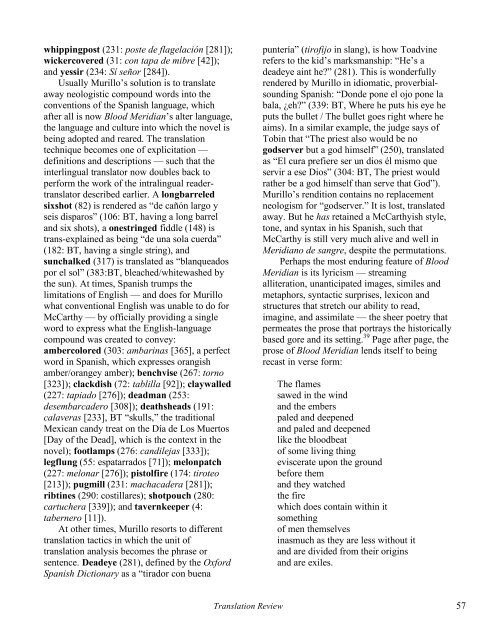Translation Review - The University of Texas at Dallas
Translation Review - The University of Texas at Dallas
Translation Review - The University of Texas at Dallas
Create successful ePaper yourself
Turn your PDF publications into a flip-book with our unique Google optimized e-Paper software.
whippingpost (231: poste de flagelación [281]);<br />
wickercovered (31: con tapa de mibre [42]);<br />
and yessir (234: Sí señor [284]).<br />
Usually Murillo’s solution is to transl<strong>at</strong>e<br />
away neologistic compound words into the<br />
conventions <strong>of</strong> the Spanish language, which<br />
after all is now Blood Meridian’s alter language,<br />
the language and culture into which the novel is<br />
being adopted and reared. <strong>The</strong> transl<strong>at</strong>ion<br />
technique becomes one <strong>of</strong> explicit<strong>at</strong>ion —<br />
definitions and descriptions — such th<strong>at</strong> the<br />
interlingual transl<strong>at</strong>or now doubles back to<br />
perform the work <strong>of</strong> the intralingual readertransl<strong>at</strong>or<br />
described earlier. A longbarreled<br />
sixshot (82) is rendered as “de cañón largo y<br />
seis disparos” (106: BT, having a long barrel<br />
and six shots), a onestringed fiddle (148) is<br />
trans-explained as being “de una sola cuerda”<br />
(182: BT, having a single string), and<br />
sunchalked (317) is transl<strong>at</strong>ed as “blanqueados<br />
por el sol” (383:BT, bleached/whitewashed by<br />
the sun). At times, Spanish trumps the<br />
limit<strong>at</strong>ions <strong>of</strong> English — and does for Murillo<br />
wh<strong>at</strong> conventional English was unable to do for<br />
McCarthy — by <strong>of</strong>ficially providing a single<br />
word to express wh<strong>at</strong> the English-language<br />
compound was cre<strong>at</strong>ed to convey:<br />
ambercolored (303: ambarinas [365], a perfect<br />
word in Spanish, which expresses orangish<br />
amber/orangey amber); benchvise (267: torno<br />
[323]); clackdish (72: tablilla [92]); claywalled<br />
(227: tapiado [276]); deadman (253:<br />
desembarcadero [308]); de<strong>at</strong>hsheads (191:<br />
calaveras [233], BT “skulls,” the traditional<br />
Mexican candy tre<strong>at</strong> on the Día de Los Muertos<br />
[Day <strong>of</strong> the Dead], which is the context in the<br />
novel); footlamps (276: candilejas [333]);<br />
legflung (55: esp<strong>at</strong>arrados [71]); melonp<strong>at</strong>ch<br />
(227: melonar [276]); pistolfire (174: tiroteo<br />
[213]); pugmill (231: machacadera [281]);<br />
ribtines (290: costillares); shotpouch (280:<br />
cartuchera [339]); and tavernkeeper (4:<br />
tabernero [11]).<br />
At other times, Murillo resorts to different<br />
transl<strong>at</strong>ion tactics in which the unit <strong>of</strong><br />
transl<strong>at</strong>ion analysis becomes the phrase or<br />
sentence. Deadeye (281), defined by the Oxford<br />
Spanish Dictionary as a “tirador con buena<br />
puntería” (tir<strong>of</strong>ijo in slang), is how Toadvine<br />
refers to the kid’s marksmanship: “He’s a<br />
deadeye aint he?” (281). This is wonderfully<br />
rendered by Murillo in idiom<strong>at</strong>ic, proverbialsounding<br />
Spanish: “Donde pone el ojo pone la<br />
bala, ¿eh?” (339: BT, Where he puts his eye he<br />
puts the bullet / <strong>The</strong> bullet goes right where he<br />
aims). In a similar example, the judge says <strong>of</strong><br />
Tobin th<strong>at</strong> “<strong>The</strong> priest also would be no<br />
godserver but a god himself” (250), transl<strong>at</strong>ed<br />
as “El cura prefiere ser un dios él mismo que<br />
servir a ese Dios” (304: BT, <strong>The</strong> priest would<br />
r<strong>at</strong>her be a god himself than serve th<strong>at</strong> God”).<br />
Murillo’s rendition contains no replacement<br />
neologism for “godserver.” It is lost, transl<strong>at</strong>ed<br />
away. But he has retained a McCarthyish style,<br />
tone, and syntax in his Spanish, such th<strong>at</strong><br />
McCarthy is still very much alive and well in<br />
Meridiano de sangre, despite the permut<strong>at</strong>ions.<br />
Perhaps the most enduring fe<strong>at</strong>ure <strong>of</strong> Blood<br />
Meridian is its lyricism — streaming<br />
alliter<strong>at</strong>ion, unanticip<strong>at</strong>ed images, similes and<br />
metaphors, syntactic surprises, lexicon and<br />
structures th<strong>at</strong> stretch our ability to read,<br />
imagine, and assimil<strong>at</strong>e — the sheer poetry th<strong>at</strong><br />
perme<strong>at</strong>es the prose th<strong>at</strong> portrays the historically<br />
based gore and its setting. 39 Page after page, the<br />
prose <strong>of</strong> Blood Meridian lends itself to being<br />
recast in verse form:<br />
<strong>The</strong> flames<br />
sawed in the wind<br />
and the embers<br />
paled and deepened<br />
and paled and deepened<br />
like the bloodbe<strong>at</strong><br />
<strong>of</strong> some living thing<br />
eviscer<strong>at</strong>e upon the ground<br />
before them<br />
and they w<strong>at</strong>ched<br />
the fire<br />
which does contain within it<br />
something<br />
<strong>of</strong> men themselves<br />
inasmuch as they are less without it<br />
and are divided from their origins<br />
and are exiles.<br />
<strong>Transl<strong>at</strong>ion</strong> <strong>Review</strong> 57

















